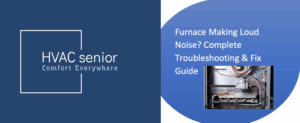Furnace Leaking Water when AC is Off [Solved].
Discovering a furnace leaking water when the AC is off can be a perplexing issue for homeowners. This unexpected situation raises concerns about potential water damage and the proper functioning of essential heating and cooling systems.
The problem could stem from various sources, ranging from clogged condensate lines and traps to issues with the drain pan or humidification system. Addressing these leaks promptly is crucial to prevent damage to the furnace components and the surrounding area.
At a glance: Furnace Leaking Water when AC is Off can be caused by Condensation Drain Issues,Clogged Condensate Trap,Cracked or Blocked Drain Pan,Humidifier Issues,High Humidity Levels or HVAC System Imbalance..Scroll below for solutions.
In this article, we will explore common reasons behind furnaces leaking water when the AC is inactive, providing insights into troubleshooting and potential solutions. Understanding these issues is pivotal for maintaining the efficiency and longevity of HVAC systems, ensuring optimal performance year-round.
Also read>>>>Furnace Shuts Off After Ignition.
Why Furnace leaking water when AC is Off.
1.Condensation Drain Issues.
When furnaces operate, the combustion process produces condensation, usually drained away through a dedicated condensate line. However, if this line becomes clogged or obstructed, water accumulates within the furnace, leading to leaks when the AC is turned off.
Fix: Inspection and Maintenance.
To address this, meticulously examine the condensate line for any impediments. Ensure the line maintains the correct slope for effective drainage.
Clearing the line of debris or cleaning the condensate trap may be necessary. Regular maintenance, including these checks, is essential to prevent blockages and maintain the furnace’s optimal performance.
By understanding and promptly resolving condensation drain issues, you safeguard your furnace from potential water damage and ensure its seamless operation. Regular inspections are key to identifying and addressing these issues before they escalate.
2.Clogged Condensate Trap.
In furnaces, the condensate trap plays a crucial role in capturing debris to prevent it from entering the drain line. When this trap becomes clogged, water accumulates within the furnace, leading to leaks when the AC is inactive.
Fix: Thorough Inspection and Maintenance.
To remedy this issue, conduct a meticulous inspection of the condensate trap. If blockages are detected, a cleaning procedure is essential. After cleaning, ensure the trap is securely in place.
Regular maintenance, including periodic checks and cleanings of the condensate trap, is vital to prevent clogs and maintain the furnace’s optimal functionality.
3.Cracked or Blocked Drain Pan.
In the furnace system, a critical component for managing excess condensation is the drain pan located beneath it. When this pan is either cracked or obstructed, water leakage occurs when the AC is not in operation.
Fix: Thorough Examination and Replacement.
To address this issue, thoroughly examine the drain pan for any visible damage or blockages. In the presence of a cracked pan, immediate replacement is necessary.
Additionally, clear any obstructions that may impede the proper functioning of the drain pan. Regular inspections and proactive replacement of damaged pans are vital to prevent water leaks and maintain the overall integrity of the furnace system.
Also read>>>>Furnace Turns On But No Heat.
4.Humidifier Issues.
Furnaces equipped with humidifiers may experience water leaks if the humidification system malfunctions. This can lead to unintended water accumulation when the AC is not in use.
Fix: Comprehensive Inspection and Repairs
To address this issue, conduct a thorough inspection of the humidifier. Check for any visible leaks and examine its components to ensure proper functioning.
If any parts are found to be faulty, initiate repairs promptly, or consider replacing the malfunctioning components. Regular checks and maintenance of the humidification system are crucial to prevent issues that may lead to water leaks and ensure the smooth operation of the furnace.
5.High Humidity Levels.
Elevated humidity within your home can result in condensation forming on the components of the furnace, leading to potential water leaks when the AC is not actively running.
Fix: Implement Dehumidification Measures
To mitigate this issue, consider the use of a dehumidifier to actively reduce indoor humidity levels. Dehumidifiers are effective in maintaining an optimal balance, preventing excessive moisture that can contribute to condensation on furnace components.
Regular monitoring of indoor humidity levels and the strategic placement of dehumidification devices contribute to a controlled environment, minimising the risk of water leaks associated with high humidity.
Understanding and addressing the impact of high humidity on furnace operation is crucial for preventing water damage and ensuring the sustained efficiency of your HVAC system.
Incorporating dehumidification measures into your home maintenance routine adds an additional layer of protection against potential issues arising from excessive moisture.
6.HVAC System Imbalance.
An HVAC system imbalance, whether stemming from incorrect sizing or a malfunctioning damper, can result in condensation issues and subsequent water leaks when the AC is inactive.
Fix: Professional Evaluation and Correction.
To address this challenge, seek the expertise of a professional HVAC technician. They can conduct a comprehensive assessment to identify and rectify any imbalances within the system.
Whether it involves adjusting sizing specifications or repairing malfunctioning dampers, the technician’s insight ensures the restoration of equilibrium within the HVAC system.
Regular consultations with HVAC professionals contribute to preventative measures and the sustained efficiency of the system.
Also read>>>>>Furnace Leaking Water.
Frequently Asked Questions (FAQs)
Why is my furnace leaking water when the AC is off?
Furnace leaks when the AC is off can be caused by condensation drain issues. During combustion, condensation is produced and usually drained away through a condensate line. I
f this line is clogged or blocked, water can accumulate and leak. Regularly check the condensate line for obstructions, ensuring it is properly sloped for drainage. Clear the line or clean the condensate trap if necessary to maintain optimal furnace performance.
What should I do if my furnace’s condensate trap is clogged?
If the condensate trap is clogged, conduct a thorough inspection and cleaning. The condensate trap is designed to prevent debris from entering the drain line. After cleaning, ensure the trap is securely in place. Regular maintenance, including periodic checks and cleanings of the condensate trap, is crucial to prevent clogs and maintain the efficiency of your furnace.
How can a cracked or blocked drain pan lead to furnace leaks?
The drain pan beneath the furnace collects excess condensation. If it is cracked or blocked, water may leak out. Regularly examine the drain pan for visible damage or blockages. Replace a cracked pan immediately and clear any obstructions to prevent water leaks and maintain the overall integrity of the furnace system.
Can high humidity levels cause my furnace to leak water when the AC is off?
Yes, extremely high humidity levels in your home can cause condensation on furnace components, leading to water leaks. Consider using a dehumidifier to reduce indoor humidity levels and maintain an optimal balance. Monitoring humidity and implementing dehumidification measures contribute to preventing water damage associated with elevated moisture levels in your home.
Conclusion.
Identifying and addressing the causes of furnace leaks when the AC is off is crucial for maintaining HVAC system efficiency and preventing water damage. Regular inspection and maintenance, including checking condensate lines, traps, drain pans, and system balance, coupled with timely repairs, ensure a seamless operation and longevity of the heating and cooling system.















